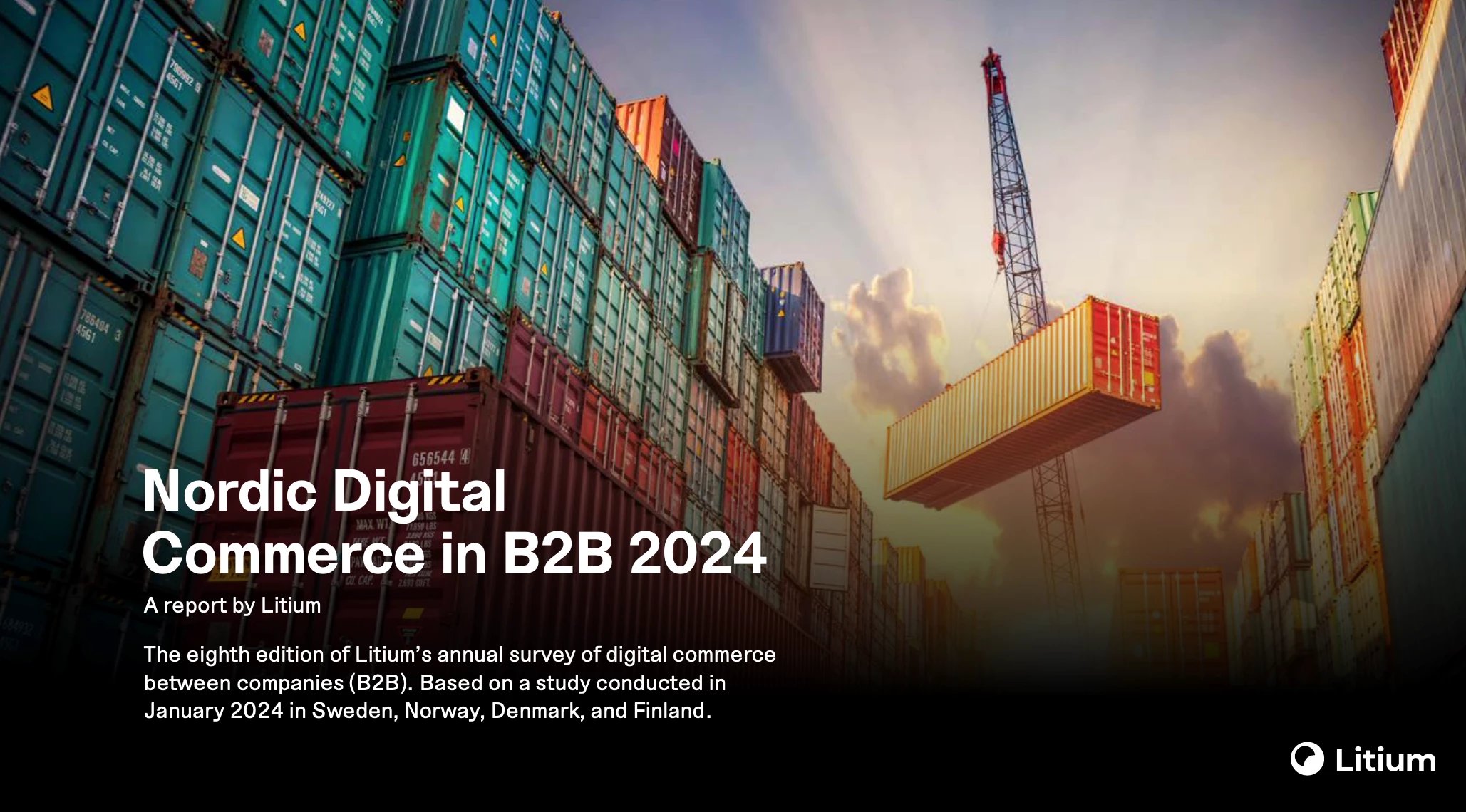Litium has just released its annual Nordic Digital Commerce in B2B report. As usual, it’s easy to digest yet comprehensive with >900 respondents. It’s the go-to source of information for benchmarking yourself and getting B2B inspiration throughout 2024.
There are several highlights in the report to acknowledge:
-
15% of the surveyed companies currently use AI, with 21% planning to start using it.
-
80% of the largest companies offer digital sales channels compared to 56% of the smaller companies.
-
71% anticipate continued growth over the next 3 years.
-
Among those not yet offering digital sales channels, 25% plan to do so within 3 years.
Size correlates with digital maturity
Litium's report reveals a direct correlation between company revenue and digital maturity: the larger the entity, the more advanced its digital commerce. Notably, the surveyed companies primarily represent small to mid-sized businesses, with 71% having annual revenues below €50 million. Consequently, entities with larger revenues must exhibit digital commerce capabilities that surpass the benchmarks set in this report to maintain a competitive edge.

Highlight: Joakim Lööv, Principal Advisor in B2B Commerce at Columbus, has analyzed the results and findings in Litium’s report about the state of B2B Commerce in the Nordics.
Alarming signals about digitalization pace in small and mid-sized B2B companies
Compared to last year’s numbers, mostly small changes are unveiled, indicating a slow uptick of digital commerce best-practices among responding companies. Many of these B2B companies are digitally immature, with 62% not offering any e-commerce solution and don’t plan to set one up within the next three years. 32% don’t enable online sales (Including product information).
This is troubling, as today’s smaller companies often strive to be tomorrow’s big ones. But, how can they get there unless their maturity either matches or surpasses the leading companies in the market?
Despite this, businesses that have integrated e-commerce solutions are seeing tangible benefits. About 30% of their transactions went through these channels (a good average albeit basically unchanged from last year). This consistent trend emphasizes the competitive advantage digital commerce provides, with companies reporting high growth expectations for their online sales.
"If you as a manufacturer plan to surpass your distributors, you need to step up and make sure your digital commerce solutions are up to the mark"
Why manufacturers should seek inspiration from wholesalers and distributors
Distributors, resellers, and wholesalers demonstrate superior digital commerce excellence compared to manufacturers. From the manufacturer’s point-of-view, this can be a non-typical reason to use distributors as part of your marketing and sales strategy. Especially as your distributors will try to stay ahead of you in the digital commerce race.
Consequently, if you are a manufacturer aspiring to surpass your distributors, you need to step up and make sure your digital commerce solutions are up to the mark (or you’ll risk losing business towards the end-customer).
 Highlight: 15% of the surveyed companies currently use AI, with 21% planning to start using it, 24% of the >€50M revenue companies already leverage artificial intelligence for digital commerce purposes.
Highlight: 15% of the surveyed companies currently use AI, with 21% planning to start using it, 24% of the >€50M revenue companies already leverage artificial intelligence for digital commerce purposes.
AI is beyond the hype
As Artificial Intelligence (AI) is on everyone's lips, Litium asked how B2B companies are leveraging AI to elevate their digital business and customer experience.
15% of the B2B companies are actively using AI, with an additional 21% planning to do invest in AI. The report shows that 56% currently have no plans for leveraging AI in their digital commerce in the near future. There’s a noticeable difference in adoption rates based on company size. Larger enterprises have made significant efforts in AI utilization for digital business development and customer experience enhancement. One number that stands out is that 24% of the >€50M revenue companies already leverage artificial intelligence for digital commerce purposes.
While early AI adopters have a clearer understanding of its use cases, not everyone has discovered the possibilities. Here are some examples of low-hanging fruits:
1) Marketing: Utilize AI to create, translate and optimize content for SEO, including product descriptions, website copy, social media posts, and other marketing collaterals.
2) Data collection and analysis: Use AI to analyze customer segments, behaviors, and preferences, along with advanced analysis of marketing campaigns, trends and competitor analysis.
3) Customer support/chatbots: Implement AI to support customer interactions while streamlining customer service through chatbots and virtual assistants.
4) Purchase recommendations/personalization: Personalize customer interactions and provide relevant product recommendations with new technology.
5) Sales enablement: Support sales efforts through CRM integration, lead generation, pricing relevance, and accurate forecasting.
Success in digitalization goes beyond technical challenges
Litium’s report continues to list aspects that prevent B2B companies from progressing in the digital sphere. The misconception that digital commerce must be less personal than traditional/physical sales still lives on, and I see many companies basing their marketing and sales strategy on this myth, possibly as an excuse for avoiding change. In combination with other non-technical obstacles for implementing digital commerce, it’s clear that being successful is more about culture, competence, decisiveness, and priority.
"Ultimately, success in digitalization extends beyond technical implementation; it depends on cultural readiness, organizational competence, and strategic decisiveness"
Summary
It felt motivational to read this year's report, mainly because digitalization is now beginning to focus on both sales and creating real customer value. Truly, it highlights both promising advancements and persistent challenges.
One key takeaway is the evident correlation between company size and digital maturity, emphasizing the importance for smaller businesses to accelerate their adoption of digital commerce practices to remain competitive. However, for those that have embraced digital commerce, tangible benefits are apparent, with a notable portion of business conducted online. Another noteworthy trend is the difference in digital excellence between distributors and manufacturers, suggesting potential learnings for manufacturers aiming to enhance their direct sales channels.
Ultimately, success in digitalization extends beyond technical implementation; it depends on cultural readiness, organizational competence, and strategic decisiveness. Prioritizing the right initiatives are critical steps toward achieving digital maturity in the changing B2B landscape outlined by Litium's report.
If you want to further explore the potential in B2B Commerce and how to get started, be sure to sign up for our webinar about B2B customer portals on May 21 at 10:30 (CET).
Best of luck with your ongoing B2B efforts in 2024. If you need more guidance, feel free to reach out to me. ✉️

